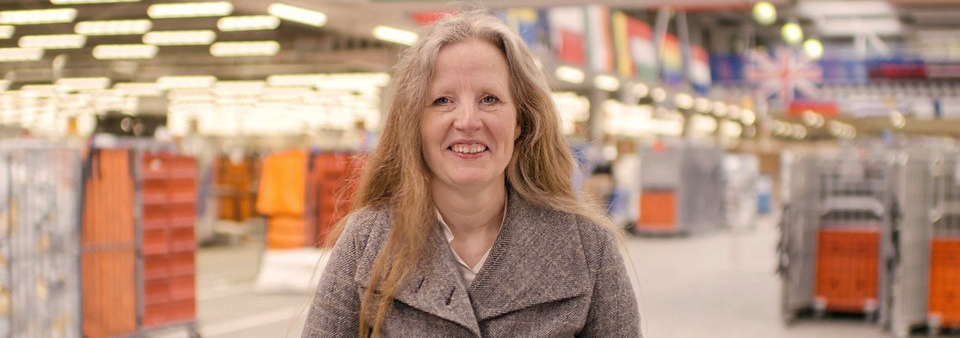To truly reduce our own environmental footprint we need to increase the number of clean kilometres we drive and travel. Although the vast majority of our last-mile mail delivery is done predominantly on foot or by bike, inter sorting-centre transport is carried out by trucks and last-mile parcel delivery by vans. Because on an average day we transport mail, parcels and goods over 1.2 million kilometres across the Benelux, we are focusing on increasing the share of renewable fuels we use as a transitional solution, as we work towards expanding the electrification of our owned and leased fleet across our networks.
As we switch from fossil fuels to a fully electric fleet, we are using renewable fuels as a transitional measure. In 2021 we scaled up our use of renewable diesel, called HVO100, on our delivery vans and large trucks across the Netherlands. As a diesel made from renewable raw materials, HVO100 produces 90% less CO2 emissions during its life cycle compared to fossil diesel. By the end of the year, the share of kilometres driven on renewable diesel by our own fleet was 13%. We also introduced the use of bio-LNG for our large trucks in 2021, and it made up 50% of the total LNG we used during the year. This helped us increase the share of the total number of kilometres we drove on bio-LNG in large trucks to 13% in 2021. The fuels we use are certified sustainable, meet high quality standards and are made of vegetable waste streams.
Going forward, we will continue to invest in decarbonising our operations through electrification and renewable fuels. This requires us to continue taking the most effective actions, collaborating with partners, and being innovative, for example by researching the viability of hydrogen-powered vehicles. However, taking the next steps on our journey will remain demanding, for example due to delays in the delivery of materials because of the pandemic. This has led to a shortage of computer chips and extended transport times of goods shipped from Asia to Europe. With the size and range of available electric vehicles not always matching our current business model, we are also considering adapting our ways of working, where possible, to accelerate our progress.
We introduced an additional 65 electric delivery vans to our fleet during the year, bringing the total number to 137, and added 513 three-wheel electric scooters to our mail delivery network. The e-scooters save more than 220,000 litres of petrol per year, cutting our annual CO2 emissions by more than 500 tons.
Throughout 2021, we have improved our data gathering and reporting processes to gain greater insights into our scope 3 CO2 emissions, including their main drivers. Using these insights, we began engaging with logistics partners to work on reducing their emissions. Our scope 3 CO2 emissions make up the majority of our absolute emissions.
Having informed our partners about our targets and plans, we began an electric-vehicle pilot with a number of delivery partners on their routes. We plan to expand this in 2022, increasing both the number of delivery partners and routes that use electric vehicles. We also began discussing the use of renewable fuels (like HVO100 renewable diesel) with our large truck delivery partners.
We work with third-parties for most of our international transport, whether by land, air or water. In 2021 we developed a detailed calculation model for air transport, which enables us to diversify the carbon impact of shipments based on different aircraft types. This helps us consider the environmental impact when selecting transport companies or transport methods. The model, which we will roll out in 2022, will lead to greater awareness within our international business and among our logistics partners, and help us select more carbon-efficient aircraft to transport our shipments. This will help us lower our scope-3 carbon footprint.

As a Sustainability programme manager at PostNL International, it’s Blîde Duk’s job to try and reduce PostNL’s CO2-emissions from international freight. But for air freight, this is a particular challenge. “Transport to other countries produces high levels of CO2-emissions”, says Blîde. “The biggest challenge is that there are currently no alternatives, especially for air freight. We use chartered trucks in place of airplanes whenever possible, as this helps us reduce emissions for destinations up to 2,500 kilometres. But trucks are slower, so sometimes flying is inevitable to get mail and parcels to their destination on time.”
Another important element in reducing emissions is loading the plane as efficiently as possible. “The pallets are packed in the shape of the plane’s cargo hold. The less air, the more mail and parcels fit in one load.” We are also collaborating with the technical university of Delft, Blîde says. “We have developed a model together that helps us choose flights that emit the least CO2, and we are exploring the possibilities of sustainable fuels.”



In 2025 we want to deliver emission-free in 25 inner cities in the Netherlands. To help achieve this, we have started rolling out light electric freight vehicles (LEFVs).
Frank Meijer delivers parcels with an LEFV in the Dutch city of Arnhem. “When I start at 7.30 AM, I unplug the LEFV and prepare the containers. We have a system with compartments that allows me to work quickly and efficiently. I start delivering on the outskirts of the city, and by 10 AM, when the shops open, I drive to the city centre. The advantage of working with an LEFV is that they don't use much energy, their agility and their size - I can easily manoeuvre through narrow alleys and park in small spaces. My last stop of the day is at the post office, where I deposit any parcels I couldn't deliver because people weren’t in. When I cycle home at the end of the day, I’m glad that my work vehicle is emission free, just like my bike.”


